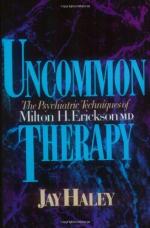
|
| Name: _________________________ | Period: ___________________ |
This test consists of 15 multiple choice questions and 5 short answer questions.
Multiple Choice Questions
1. One of the most prominent facts about Chapter 5 is that what early in a marriage are a common and readily treatable problem?
(a) Sexual difficulties.
(b) Compatibility issues.
(c) Financial worries.
(d) Dominance difficulties.
2. In one scenario in Chapter 5, Erickson was ignorant in matters of baby gender prediction, but he did recommend _____ to avert disaster.
(a) Medication.
(b) Institutionalization.
(c) Separation.
(d) Divorce.
3. Therapy is meant to facilitate the transition of a person from the situation of being a child into being what?
(a) None of the answers is correct.
(b) An independent adult.
(c) A functioning adult.
(d) A codependent adult.
4. The therapist deals with each part of the couple _______, as a general rule.
(a) As a family unit.
(b) Separately.
(c) Together.
(d) Separately and together.
5. Erickson's method is in contrast to other forms of talk therapy where there is a greater emphasis on __________, and the relationship tends to involve weekly meetings for years on end.
(a) Evaluating the client's history.
(b) Evaluating the client's emotions.
(c) Understanding the anxieties of the client.
(d) Understanding the client
6. After Erickson's client secured the job in Chapter 3, the therapist asked for details about how corrections were made when the client revealed that there had been _____.
(a) A foreclosure.
(b) A promotion.
(c) Mistakes.
(d) A resignation.
7. Haley points out that Erickson had suffered from _____ twice and had been debilitated by it/them.
(a) Heart attacks.
(b) Nervous breakdowns.
(c) Polio.
(d) Strokes.
8. The period of adolescence that often closely predates major mating activity is one of the most important times for people to do what?
(a) Appreciate their families.
(b) Receive any necessary therapy.
(c) Branch out on their own.
(d) Receive medication if needed.
9. Erickson writes of withholding and sharing information and of how he succeeds in curing a young woman of pain she experiences during ______.
(a) Marriage.
(b) Intercourse.
(c) Menstruation.
(d) Childbirth.
10. The author does not mention the issue of whether to ______ when he mentions the matter of marriage.
(a) Accept homosexuality.
(b) Divorce.
(c) Parent.
(d) Live separately.
11. Haley states in Chapter 2, there is a need for the ______ to make a major adjustment towards the relationship of another family member but also to another family.
(a) Parents.
(b) Friends.
(c) Siblings.
(d) Entire family.
12. Hypnosis is described as a special way of _______.
(a) Beaconing.
(b) Brain washing.
(c) Administering help.
(d) Communicating.
13. One marital trouble that can occur was exemplified in Chapter 5 as the case of a young wife with a _____ hand.
(a) Itchy.
(b) Trembling.
(c) Blotchy.
(d) Numb.
14. Haley explains that Erickson, in dealing with ______, does not attempt to change their fundamental nature and does not even try to confront the real problem directly.
(a) Parents.
(b) Adolescents.
(c) Children.
(d) Grandparents.
15. Harold succeeds in cultivating a friendship with an unintelligent ______ man who has been highly effective at making the best of who he is.
(a) Fatherly.
(b) Handicapped.
(c) Wealthy.
(d) Educated.
Short Answer Questions
1. Haley writes that the majority of the young adults who the therapist meets with do want to ____.
2. Often enough, if the woman did not have a good experience with what from the beginning would she seek an annulment of the marriage?
3. In Chapter 5, Erickson and Haley both admit that not all young adults want to do what?
4. In Chapter 4, it becomes apparent over time that Harold is a very _______ worker.
5. Erickson typically conducts therapy with the goal of keeping a couple together except for two types of case: one, if the couple feels the marriage was a mistake, and second, in the event that the marriage does what?
|
This section contains 591 words (approx. 2 pages at 300 words per page) |

|




